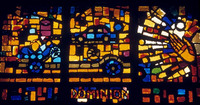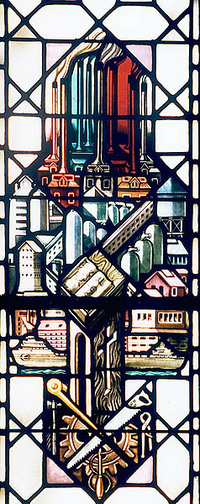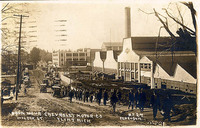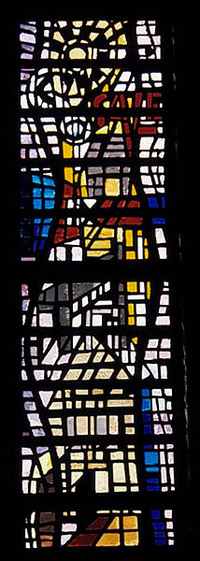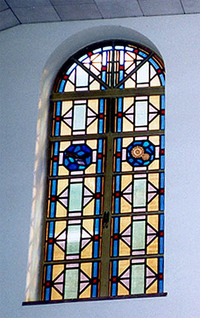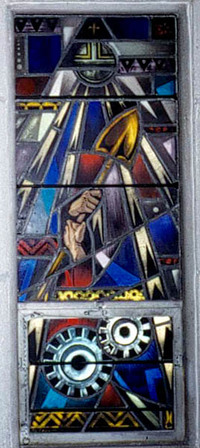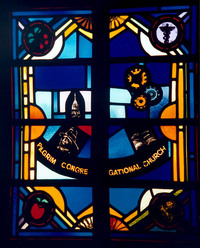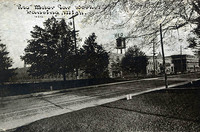MSGC : Featured Windows : Current Window
Featured Windows, October 2006
"A Workman Approved Unto God": Work, Faith and the Automotive Industry in Michigan's Stained Glass
Buildings:
St. Pius X Church - Flint, Michigan
St. James Lutheran Church - Grand Rapids, Michigan
First English Evangelical Lutheran Church - Grosse Pointe Woods, Michigan
First United Methodist Church of Dearborn - Dearborn, Michigan
Pilgrim Congregational Church - Lansing, Michigan
Christian Fellowship of Love Baptist Church - Detroit, Michigan
"HAVE DOMINION OVER THE EARTH" (window II). Marian Owczarski, Orchard Lake, MI, 1978. St. Pius X Church, Flint, MI. MSGC 95.0019. Photo by Robert Voto.
The word "DOMINION" seems a fair, if not somewhat bittersweet starting point for a brief survey of the relationship between industrial imagery and the automotive industry in Michigan's stained glass. The automotive industry has been a ubiquitous feature of Michigan's identity for generations. One needs only to pick up a newspaper to learn of how its economic struggles of recent decades have been the subject of national debate and personal hardship for many. Whatever future this industry holds for its workers in Michigan and elsewhere, there remains a material remembrance of the days of dominion. It can be found in churches of various denominations in references simple or complex. The examples we have located so far are all fairly recent, dating from the 1950s to the late 1970s.
In truth, "Dominion" does not refer specifically to the subject of this window — from
St. Pius X Church in Flint, MI — but is part of the phrase "HAVE DOMINION OVER THE EARTH"— which is spread over five not-all-subject-related stained glass windows that refer to Christ, Creation and local life in Flint.
1 The unusual
dalle de verre (faceted) windows were completed in 1978, the work of Polish-born sculptor and stained glass artist Marian Owczarski, of Orchard Lake, MI. According to Fr. Vincent DeLorenzo, pastor of St. Pius from 1976-1983, the windows were a collaborative effort between artist, diocese and parish. Their intent was to create a space that had personal link to the church members while instilling a Christian sense of work ethic: "We were a working class parish at that time with a solid family orientation and we wanted the lay people to get involved. We hear Jesus say you have to work hard, use your hands and your back, to make a living."
2 This "working class" themed window is one of two in St. Pius dedicated to Flint's autoworkers. In this scene we decipher, in the left and center sections, a chassis moving along an assembly line, a completed automobile, and an oil drum. A church history describing the windows notes "other symbols having to do with the automotive industry," but the medium of the dalle de verre makes it difficult to read the details.
3
Left: "HAVE DOMINION OVER THE EARTH" (window V). Marian Owczarski, Orchard Lake, MI, 1978. St. Pius X Church, Flint, MI. MSGC 95.0019. Photo by Robert Voto.
Right: "Noon Hour Chevrolet Motor Co. Flint, Mich." Postcard, postmarked 1921, Ferguson. Collection of Michigan State University Museum, acc# 5657.69.20. Known as "Vehicle City" from its days as a leader in the buggy and carriage industry, Flint has been home to General Motors and a number of major industrial complexes, including Buick Motor Company, AC Spark Plug, Fisher Body and Chevrolet.
4
A second window dedicated to automotive workers with the inscription "EARTH" varies from the first, which concerns itself solely with the products of industry. It focuses on the worker and expresses a point of view regarding struggles between labor unions and management. In this scene, to the far left we see three factory gears— representing a logo of General Motors at the time— and to the far right a factory gear that recalls the well-known gear logo of the UAW (United Auto Workers) labor union, but with a cross in its center. In the middle section is the figure of an autoworker, bent in a laboring posture, the arc of his back mirroring the curves of the factory gears. Our overall sense of the scene is that the worker is a cog in the functioning industrial machine, as are the gears of union and management. The chunky, non-realistic quality of the composition emphasizes this as well, effacing our sense of an individual worker. While a work by another artist in another setting might make a political point about the placement of the worker in this type of posture, the intent here was actually one of neutrality. Fr. DeLorenzo describes the scene in this way: "It... symbolizes working together... The last window shows a UAW symbol with a cross in the middle. A human being is pictured between the two symbols as if the person is in the middle of management and labor, in a position of struggle between the two."
5 The intent then for the individual is to remain a balancing force between the struggling labor and management, for the common good.
"Lay Person's Window." George L. Payne Studio, Paterson, NJ, 1972. First United Methodist Church, Dearborn, MI. MSGC 97.0116. Photo by Donald Sigman.
Another approach to the representation of automotive imagery in stained glass is the George L. Payne Studio's sleek and simple rendering of the Ford Motor Rouge Plant, completed in 1972 for the
First United Methodist Church in Dearborn, MI. The window, incidentally, is paired with a window depicting a church building,
6 a balancing of the space that dominates many parishioners' daily lives with the space that should be dominating their inner lives. And if a dominating workspace were ever articulated, the Ford Rouge Plant would be it. The Rouge Plant epitomized Henry Ford's concept of "vertical integration,"
7 the development of a finished product from raw materials in one location. Designed by Detroit architect Albert Kahn, the Ford Rouge Plant became the largest industrial complex in the world by the late 1920s, with its own power, glass, cement plant and by-products plants and 16 assembly plants. The City of Dearborn's location on the River Rouge enabled ships to bring iron ore, coal, limestone and lumber directly to the Ford Plant, which also had direct access from 92 miles of railway track.
8 Although this window here lacks a human figure like Owczarski's labor figure, we can still get a sense of intended grandeur in the depiction of the Rouge Plant, as the complex dwarfs the freighter ship on the water in the foreground. But, even more importantly, a keystone symbol inset centrally among the various buildings is that of an open Bible on a lectern, again a reminder of the central prominence of faith in daily life. Below the Bible are symbols of various trades— a saw, factory gear, compass, tongs, awl and hammer. Its inscription reads: "A Workman: Approved Unto God," which comes from the Book of 2 Timothy ("An Approved Workman"): "Study to show thyself approved unto God, a workman that needeth not to be ashamed, rightly dividing the word of truth."
9
A common thread of most of the windows we have found is this principle of the "Approved Workman." Although 2 Timothy has more to do with a need for commitment to faith in the face of persecution and worldly temptation, the Payne window focuses on literal "work" as an expression of faith in daily life. A number of churches have what we can call "vocational" or "occupational" windows, of which First United Methodist's "Lay Person's Window" is an example. Such windows feature symbolism of various trades, often associated with their local communities— which is why the factory gear and automotive imagery are most likely (although not always necessarily) to be found in these windows. When written materials have been produced to interpret the windows, such as window guides or sections in church histories devoted to church artwork, the language used to describe their purpose conveys a sense of faith and godliness in one's secular pursuits. St. James Lutheran Church of Grand Rapids' description of its "Vocation Window" (fig. 5) reads: "Live your Christian faith in your vocation! In the house you call home; as you are at your desk at school; if you are standing at the workman's bench; in the sales world; or if you are working by the large wheels of industry."
10 Redford United Methodist Church in Detroit describes the imagery in their three window "Vocation" grouping (fig. 6) as indicative of "the close relationship between our Christian faith and our everyday vocations...through which men are partners with God."
11 First English Evangelical Lutheran's (Grosse Pointe Woods— fig. 7) literature describes its "Our Callings" window imagery as representative of the work Christians must do "to the Glory of God": "From worship they return to these callings in order to serve Him in daily life... The shovel is a symbol of all work being done to the glory of God with industry represented by the meshing gear also called to do the same."
12
Left: "Vocation Window." Universal Studios, Richard Caemmerer, designer, Valparaiso, IN,1968. St. James Lutheran Church, Grand Rapids, MI. MSGC 97.0005. Photo by Albert Heldt.
Right: "Vocation Windows". Detroit Stained Glass Works, Detroit, MI,1957. Redford United Methodist Church, Detroit, MI. MSGC 93.0084. Photo by Mary Ann Anderson.
"Our Callings" Windows. Willet Studios, attributed to Ann Willet Kellogg,
13 designer, Philadelphia, PA, 1963. First English Evangelical Lutheran Church, Grosse Pointe Woods, MI. MSGC 97.0063. Photo by Marti Miller.
Although the three windows above make no specific reference to the automotive industry (parishioners in Detroit and its suburb of Grosse Pointe Woods in particular might make what they will of the imagery, given their personal experiences in the region), they are notable in their differences from the Flint and Dearborn windows, which combine the factory gear symbol with parish- and region-specific industrial imagery. The reduction of industry from product-process-worker to symbol allows a universal image that integrates easily into the worship environment and probably is reusable for the studios.
Left: "Lansing Window." Edith Hazzard Wright, Haslett, MI, 1976. Pilgrim Congregational United Church of Christ, Lansing, MI. MSGC 98.0005. Photo by Louella Wonch.
Right: "'Reo' Motor Car Works. Lansing, Mich." Postcard, postmarked 1920, photographer unknown. Collection of Michigan State University Museum, acc# 5720.7.13. Michigan's capital of Lansing has long been synonymous with the names of "Reo" and Oldsmobile. The Olds Motor Vehicle Co. was founded there by Ransom E. Olds in 1897 with the financial backing of local businessman Edward W. Sparrow. The company was acquired by General Motors in 1908 and was a major feature of the local economy until it ceased production in 2004.
14
Edith Hazzard Wright, an Ann Arbor, MI native who reportedly worked for a time with the Willet Studios before ultimately settling in Lansing's suburb of Haslett,
15 used the factory gear motif on the "Lansing Window" (fig. 8) she created for her own church, Pilgrim Congregational United Church of Christ in Lansing. One of several symbols that depict various aspects local life and history, the factory gear trio (upper right quadrant) is Wright's compact visual marker for the primacy of industry— particularly the automotive industry
16— in the lives of Pilgrim Congregational's members. A bee in the bottom right corner, although often used traditionally in churches as the symbol of St. Ambrose,
17 is used here in honor of the workers of Pilgrim Congregational. Wright, who clearly is comfortable using symbols for specific purposes as opposed to the traditional or universal, economizes the local industry into the factory gear motif. The flip side of the generic factory gear that represents all industry, this is Wright's visual gamble that in the right worship setting and the right town, the factory gear can replace more complex imagery and still retain specific meaning.
Notes:
- St. Pius X Catholic Church (Flint, MI.). 40th Anniversary, 1955-1995. Flint, MI: The Church, [1995?], pp. 22-23. The phrase "Have dominion over the earth" was suggested for the window by St. Pius' Spiritual Development Commission. The line paraphrases from Genesis 1:28, "And God blessed them, and God said unto them, Be fruitful, and multiply, and replenish the earth, and subdue it: and have dominion over the fish of the sea, and over the fowl of the air, and over every living thing that moveth upon the earth." Gen. 1.28 The Holy Bible, King James Version. (New York: American Bible Society: 1999). Published May 2000 by Bartleby.com; © Copyright Bartleby.com, Inc.
- St. Pius X Catholic Church, p. 22.
- The right section of the window depicts a hand, leading into the imagery of the next window, an expansive open-armed depiction of Christ.
- Genesee County Historical Society. Flint, 1890-1960. Charleston, SC: Arcadia Publishing, 2004, p. 7, 10.
- St. Pius X Catholic Church, p. 23.
- The church building is that of the Webster Hills United Methodist Church in Webster Hills, MO, a church pastored by the brother of Clyde P. McKelvy, the person memorialized by this window. Window data form N4. Michigan Stained Glass Census file 97.0116, Michigan State University Museum, East Lansing, MI.
- Cabadas, Joseph. River Rouge: Ford's Industrial Colossus. St. Paul, MN: Motorbooks International, 2004, pp. 9-10. More recently the plant has been known as the Ford Rouge Center.
- Hutchison, Craig and Kimberly Rising. Dearborn Michigan. Charleston, SC: Arcadia Publishing, 2003, pp. 55-56.
- 2 Tim. 14 The Holy Bible, King James Version. (New York: American Bible Society: 1999). Published May 2000 by Bartleby.com; © Copyright Bartleby.com, Inc.
- St. James Lutheran Church (Grand Rapids, MI). "The Arts at St. James Lutheran Church" (booklet). Michigan Stained Glass Census file 97.0005, Michigan State University Museum, East Lansing, MI, p. 4.
- Redford/Calvary United Methodist Church (Detroit, MI). "Symbols in Our Stained Glass Windows" (booklet). Michigan Stained Glass Census file 93.0084, Michigan State University Museum, East Lansing, MI, p. 21.
- First English Lutheran Church (Grosse Pointe Woods, MI). "Self-guided tour," First English Lutheran Church (booklet). Michigan Stained Glass Census file 97.0063, Michigan State University Museum, East Lansing, MI, p. 10.
- Correspondence and design copies from Willet Studios, Michigan Stained Glass Census file 97.0063, Michigan State University Museum, East Lansing, MI.
- Binder, Alan K. and Deebe Ferris, eds. General Motors in the 20th Century. Southfield, MI: Ward's Communications, c2000, p. 1, 277.
- Halfman, Janet, "Artist Works with Stained Glass," source unknown, c1976. Michigan Stained Glass Census file 98.0005, Michigan State University Museum, East Lansing, MI.
- Window data form B10, Michigan Stained Glass Census file 98.0005, Michigan State University Museum, East Lansing, MI.
- St. Ambrose's association with bees— which symbolize his eloquence— comes from a story describing the infant Ambrose, as "a swarm of bees settled upon his mouth, causing his elders to predict great oratorical gifts." Webber, Frederick Roth. Church Symbolism; An Explanation of the More Important Symbols of the Old and New Testament, the Primitive, the Mediaeval, and the Modern Church. Cleveland: J. H. Jansen, 1927; reprint, Detroit: Gale Research Co., 1971, p. 228.
Bibliography:
Show BibliographyBinder, Alan K. and Deebe Ferris, eds. General Motors in the 20th Century. Southfield, MI: Ward's Communications, c2000.
Cabadas, Joseph. River Rouge: Ford's Industrial Colossus. St. Paul, MN: Motorbooks International, 2004.
Dearborn Historical Museum. Dearborn: Proud Past, Bright Future. Dearborn, MI: Dearborn Historical Museum, 2004.
First English Lutheran Church (Grosse Pointe Woods, MI). "Self-guided tour," First English Lutheran Church (booklet). Michigan Stained Glass Census file 97.0063, Michigan State University Museum, East Lansing, MI
Genesee County Historical Society. Flint, 1890-1960. Charleston, SC: Arcadia Publishing, 2004.
Halfman, Janet, "Artist Works with Stained Glass," source unknown, c1976. Michigan Stained Glass Census file 98.0005 , Michigan State University Museum, East Lansing, MI.
Hutchison, Craig and Kimberly Rising. Dearborn Michigan. Charleston, SC: Arcadia Publishing, 2003.
Redford/Calvary United Methodist Church (Detroit, MI). "Symbols in Our Stained Glass Windows" (booklet). Michigan Stained Glass Census file 93.0084, Michigan State University Museum, East Lansing, MI.
St. James Lutheran Church (Grand Rapids, MI). "The Arts at St. James Lutheran Church" (booklet). Michigan Stained Glass Census file 97.0005, Michigan State University Museum, East Lansing, MI.
St. Pius X Catholic Church (Flint, MI.). 40th Anniversary, 1955-1995. Flint, MI: The Church, [1995?].
Webber, Frederick Roth. Church Symbolism; An Explanation of the More Important Symbols of the Old and New Testament, the Primitive, the Mediaeval, and the Modern Church. Cleveland: J. H. Jansen, 1927; reprint, Detroit: Gale Research Co., 1971. (MSGC 1995.0019, 1998.0019, 1997.0116, 1997.0005, 1993.0084, 1997.0063, 1998.0005)
Text by Michele Beltran, Michigan Stained Glass Census, October , 2006.

